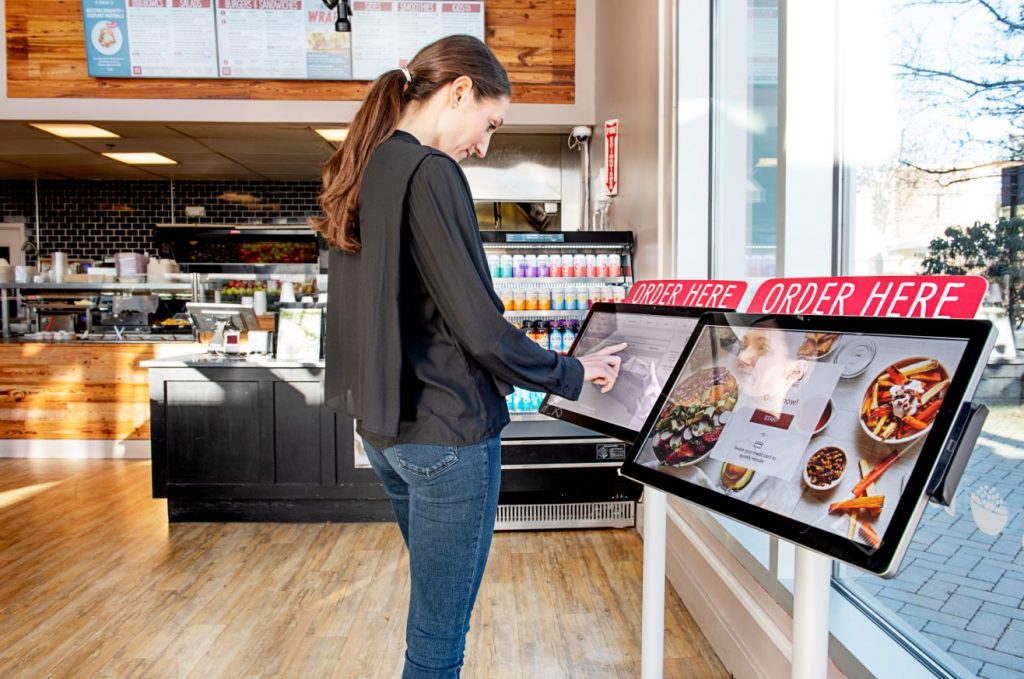- 27 October 2023
- by Andrej Fedek
- Blog, Business, eCommerce
- 0 Comments
Technology is changing how we shop, and the digital menu is a great example of this. This digital tool is providing big benefits for both stores and customers – it makes shopping easier and better for everyone. But what makes a digital menu successful? And how can retailers use it effectively? In this article, we’ll explore these questions, discuss the key elements of successful digital menus, offer advice on how to implement them, provide design tips, and weigh the pros and cons.
Understanding the Role of Digital Menus in Retail
Digital menus play a crucial role in retail by enhancing the overall customer experience and streamlining business operations. They offer real-time updates, reducing order errors and even driving sales to more profitable items.
You can instantly update your menu, display sold-out items, and change prices on the fly. Plus, they improve efficiency – no more misheard orders or printing costs. They also provide a better customer experience. Your staff can focus more on hospitality instead of taking orders.
And let’s not forget about the benefits to your bottom line. With faster table turnover and the ability to encourage customers to order more, your revenues could see a nice boost. So, it’s clear: digital menus are a win-win for both the store and the customers.
Key Features of Successful Digital Menus in Retail
There are key features that make digital menu solutions successful in a retail environment. These features include:
User-Friendly Interface
A well-designed digital menu should be easy for customers to use. It should be intuitive, requiring minimal clicks or swipes to find the desired information, and have a clear, readable layout and font size.
Clear Categorization
Products should be organized neatly into categories and sub-categories. This means that if a customer is looking for a specific product or type of product, they should be able to find it easily without having to sift through unrelated items.
High-Quality Visuals
Every product should be accompanied by a high-quality image. This gives customers a better idea of what they’re buying, which can make them more likely to purchase. It can also help to showcase the product in its best light, making it more appealing to potential buyers.
Flexibility
One major benefit of digital menus is that they can be quickly and easily updated. This allows you to keep your menu fresh and relevant, changing items and prices as needed without the need for a complete redesign.
Real-Time Changes
With a digital menu, you have the ability to update pricing, promotions, or availability immediately. This gives you a competitive edge, as you can react to market changes quickly and effectively.
Scheduled Updates
Digital menus allow you to plan changes in advance and schedule them to go into effect at specific times or events. This means you can ensure your menu is always up-to-date and that special promotions or limited-time offers are available at the right time.
Integration with Point of Sale
This ensures that any changes you make to your digital menu are instantly reflected at the point of sale, reducing chances of pricing or product errors.
Cross-selling and Upselling
Digital menus can help drive sales by suggesting complementary items or upgrades.
Multilingual Support
If your retail environment serves a multicultural audience, supporting multiple languages would be highly convenient and improve user experience.
Calorie and Nutritional Information
Particularly relevant for food retailers, providing this information can help customers make informed choices about their purchases.
Interactive Elements
Including interactive elements like reviews, ratings, or even simple games can enhance the user experience and increase customer engagement.
Customizable Templates
Having customizable templates allows you to maintain brand consistency across all digital menus and platforms while saving time on design.

Implementing Digital Menus in Your Retail Store
Once you’ve decided to incorporate digital menus into your retail store, it’s crucial that you understand the implementation process to ensure a smooth transition and maximum customer engagement.
- Start by selecting a digital menu software or platform that suits your needs.
- Train your staff on how to use the system efficiently.
- Don’t forget to integrate the digital menu with your Point of Sale (POS) system for seamless order management.
- Promote the availability of digital menus to your customers through in-store signage and online platforms.
- Make sure to gather feedback from both staff and customers for continuous improvement.
Tips for Designing Engaging Digital Menus
When you’re crafting an engaging digital menu, the design plays a pivotal role. It’s important to choose suitable fonts and colors and to incorporate photos and videos effectively.
Additionally, optimizing your menu for different devices can significantly enhance the user experience.
Choosing Suitable Fonts, Colors
While you’re selecting the perfect font and color for your digital menu, it’s crucial to remember that legibility and contrast can greatly influence a customer’s shopping experience. Consider the following tips:
- Fonts: Choose a simple, clear font that’s easy on the eyes. Avoid cursive or overly stylized fonts that might be tough to read.
- Colors: Opt for high-contrast color combinations. Dark text on a light background or vice versa works best. Stick to your brand colors for consistency but ensure they don’t negatively affect readability.
Incorporating Photos and Videos Effectively
You’ve got your fonts and colors figured out, and now it’s time to step up your game by effectively incorporating photos and videos into your digital menus.
High-quality images are essential. They not only add visual appeal but also help customers make decisions. Use clear, crisp photos that accurately represent your products. Avoid over-editing, as authenticity sells.
Videos, on the other hand, can provide a dynamic touch. Use them to showcase product features, share behind-the-scenes glimpses, or tell your brand story. However, keep them short and ensure they don’t slow down your menu’s loading time.
Optimizing for Different Devices
After sorting out your visuals, it’s time to focus on optimizing your digital menus for different devices, ensuring a seamless user experience across all platforms.
Here are some tips to get you started:
- Adapt to screen size
Make sure your menu is responsive, meaning it adjusts automatically to different screen sizes. This ensures that customers have a great experience whether they’re using a smartphone, tablet, or desktop computer.
- Test your design on various devices
- Use scalable vector graphics for images
- Consider touch interfaces
Many users will interact with your menu on a touchscreen, so make buttons large and easy to press. Avoid hover effects, as these don’t work on touchscreens
Evaluating the Costs and Returns of Digital Menus
You should consider the cost of putting digital menus into place, including buying the needed equipment and software and paying for design and setup. This, along with understanding potential financial returns, will help you decide if it’s a good investment.
However, don’t forget to factor in the ongoing costs such as software updates, maintenance, and potential repairs.
On the flip side, the returns on your investment can be significant. Digital menus enhance the customer experience, potentially leading to increased sales. They also offer operational efficiencies, reducing costs related to menu printing and updates.
Lastly, they enable data collection for improved business decision-making.
Pros and Cons: Weighing the Benefits of Digital Menus Against the Drawbacks
In this section, you’ll dive into the advantages and disadvantages of digital menus, balancing the exciting benefits against potential challenges.
Advantages:
- Efficiency: Digital menus streamline operations, freeing up staff time and reducing errors.
- Versatility: You can quickly update offerings, prices, or promotions.
- Engagement: Multimedia capabilities can enhance customer interest and interaction.
Disadvantages:
- Initial costs: The upfront investment in hardware and software might be daunting.
- Technical glitches: System crashes or internet issues can disrupt service.
Conclusion
Digital menus are transforming the retail industry, providing a range of benefits that can improve operations and customer experience. Despite the initial cost, the potential returns are significant.
If retailers learn about the main features of a good digital menu and use them correctly, they can improve their customer’s in-store experience and keep up with competitors in this digital world.

Andrej Fedek is the creator and the one-person owner of two blogs: InterCool Studio and HarmonyStart. As an experienced marketer, he is driven by turning leads into customers with White Hat SEO techniques. Besides being a boss, he is a real team player with a great sense of equality.




